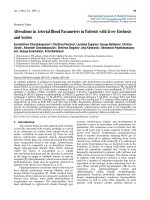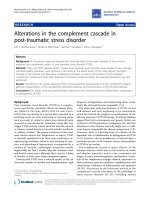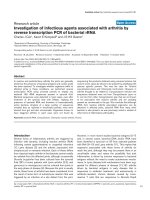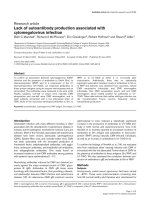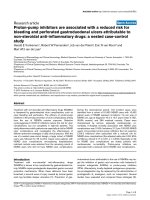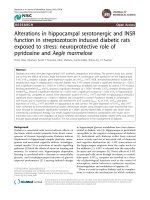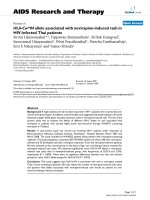Báo cáo y học: " Alterations in transcriptional responses associated with vascular aging" ppsx
Bạn đang xem bản rút gọn của tài liệu. Xem và tải ngay bản đầy đủ của tài liệu tại đây (218.56 KB, 5 trang )
BioMed Central
Page 1 of 5
(page number not for citation purposes)
Journal of Inflammation
Open Access
Review
Alterations in transcriptional responses associated with vascular
aging
Yumei Zhan, Lei Yuan and Peter Oettgen*
Address: Division of Cardiology, and Molecular and Vascular Biology, Department of Medicine, Center for Vascular Biology Research, Beth Israel
Deaconess Medical Center, Boston, Massachusetts, USA
Email: Yumei Zhan - ; Lei Yuan - ; Peter Oettgen* -
* Corresponding author
Abstract
Vascular aging is an independent risk factor for cardiovascular disease that can occur in the absence
of other traditional risk factors. Inflammation is a hallmark of vascular aging that ultimately leads to
structural changes in the vessel wall including an increase in medial thickness and perivascular
fibrosis. Several classes of transcription factors have been identified that participate in the
regulation of cellular responses associated with vascular aging. Nuclear factor (NF)-κB is the
prototypic example of a transcriptional activator in the setting of inflammation, being activated in
response to multiple inflammatory mediators including pro-inflammatory cytokines and bacterial
endotoxin. In contrast, the activation of the nuclear hormone receptor and transcription factor
peroxisome proliferator-activated receptor-alpha (PPAR-α) results in its translocation from the
cell surface to the nucleus where it exerts anti-inflammatory effects. Vascular aging is also
associated with endothelial dysfunction. One important repair mechanism for improving
endothelial function is the recruitment of endothelial progenitor cells (EPCs). In the setting of aging
the number of EPCs diminishes which has been linked to a decrease in the activity and/or
expression of the transcription factor hypoxia inducible factor (HIF)-1 alpha. A change in the
balance of the activity of pro-inflammatory transcription factors versus those that inhibit
inflammation likely contributes to the process of vascular aging. The purpose of this review is to
summarize our current knowledge of these age-related changes in transcriptional responses, and
to discuss the therapeutic potential of targeting some of these factors.
Arterial aging
Epidemiological studies strongly support that vascular
aging, which is accompanied by increased arterial stiffness,
is an independent risk factor for cardiovascular morbidity
and mortality [1-4]. Arterial stiffness is also frequently asso-
ciated with the presence or the development of hyperten-
sion [5,6]. Whether an increase in arterial stiffness always
precedes the onset of hypertension has not been deter-
mined. Although the precise molecular mechanisms under-
lying arterial aging have not been elucidated, inflammation
appears to be a central component [7-9]. Some of the medi-
ators of this inflammatory response include pro-inflamma-
tory cytokines such as tumor necrosis alpha (TNF-α),
transforming growth factor-beta (TGF-β), and angiotensin
II (Ang II). The focus of this article is to review some of the
transcriptional mediators that are responsible for activating
critical genes involved in the initiation and propagation of
vascular aging (Table 1).
Published: 21 May 2009
Journal of Inflammation 2009, 6:16 doi:10.1186/1476-9255-6-16
Received: 5 March 2009
Accepted: 21 May 2009
This article is available from: />© 2009 Zhan et al; licensee BioMed Central Ltd.
This is an Open Access article distributed under the terms of the Creative Commons Attribution License ( />),
which permits unrestricted use, distribution, and reproduction in any medium, provided the original work is properly cited.
Journal of Inflammation 2009, 6:16 />Page 2 of 5
(page number not for citation purposes)
NF-κB
NF-κB is known as the prototypic transcriptional media-
tor of inflammation. Under non-inflammatory condi-
tions the heterdimeric Rel domain subunits, p50 and p65,
of NF-κB are constitutively expressed but remain inacti-
vated in the cytoplasm bound to the inhibitory protein Iκ-
B. In response to inflammation Iκ-B is degraded allowing
p50 and p65 to form NF-κB that can now freely translo-
cate to the nucleus [10]. It was recently demonstrated that
not only the expression but the activity of NF-κB is up-reg-
ulated during the process of aging [11,12]. The expression
and activity of NF-κB was evaluated in fibroblasts from
patients with ages ranging from 22 to 92 years of age. Over
time there was a significant increase in the activity of NF-
κB and the expression of inflammatory genes.
During the process of vascular aging there is a similar
increase in NF-κB expression and activity in vascular
smooth muscle cells and endothelial cells. This has been
attributed to a variety of different mechanisms [13]. First,
there is an increase in the levels of circulating cytokines,
and in particular TNF-α during the process of aging. Sec-
ond, vascular aging is associated with the increased pro-
duction of reactive oxygen species (ROS), and in
particular mitochondrial-derived H
2
O
2
due to age-related
mitochondrial dysfunction [12,14,15]. In the vascular
endothelium age related increases in the expression of NF-
κB are associated with increased expression of monocyte
chemoattractant protein 1 (MCP-1) and a reduction in
endothelium-dependent dilation [16]. Similarly the activ-
ity and response of NF-κB to pro-inflammatory cytokines
was enhanced in aged compared to young vascular
smooth muscle cells and was associated with an augmen-
tation of the induction of ICAM-1 and inducible nitric
oxide synthase (NOS2) genes [17].
Hypoxia Inducible Factor-1 alpha (HIF-1α)
HIF-1α is a member of the transcription factor family and
has been shown to be a critical regulator of neovasculari-
zation [18]. HIF-1α is activated in the setting of hypoxia
and promotes the expression of vascular endothelial
growth factor (VEGF) [19]. In the setting of myocardial
ischemia or infarction the activation of HIF-1α promotes
local angiogenesis through the expression of VEGF. In
addition HIF-1α can induce the expression of stromal cell-
derived factor-1 (SDF-1) [20]. SDF-1 enhances the recruit-
ment of endothelial progenitor cells (EPCs) in the setting
of tissue injury or ischemia. One of the hallmarks of vas-
cular aging is endothelial dysfunction. EPCs can promote
the repair of dysfunctional or damaged endothelium.
Recent studies suggest that the levels and activity of HIF-
1α diminish with aging and thereby leads to reduced lev-
els of SDF-1 [21,22]. The results of these studies suggest
that both local proliferation of endothelial cells by VEGF
in the setting of ischemia, and the recruitment of EPCs to
promote neovascularization or repair damaged endothe-
lium are diminished with aging.
ETS factor family
The ETS factors are a family of transcription factors that
share a highly conserved DNA binding domain (Ets
domain). ETS factors are involved in regulating a wide
variety of biological processes including normal develop-
ment and differentiation [23]. Until recently, very little
was known about a role for ETS factors in regulating vas-
cular inflammation. Over the past few years several stud-
ies have been completed that support a role for several
ETS family members in the regulation of vascular inflam-
mation, including endothelial activation in response to
inflammatory mediators, the recruitment of inflamma-
tory cells to the vessel wall, and proliferation and migra-
tion of vascular smooth muscle cells. We and others have
observed that Ets-1 is induced in VSMC and endothelial
cells in response to a variety of stimuli including Angi-
otensin II (Ang II), PDGF-BB, thrombin, interleukin-1
beta (IL-1β), and tumor necrosis alpha (TNF-α) [24-30].
Target genes identified to be downstream of Ets-1 in the
setting of acute vascular inflammation include the chem-
okine MCP-1 and the adhesion molecule VCAM-1. Sys-
temic administration of the vasoactive peptide Ang II via
continuous infusion is not only associated with increases
in blood pressure but also promotes the recruitment of
Table 1: Roles of selected transcription factors in vascular inflammation and aging
Transcription Factors Pro-/Anti-inflammatory Selected Target Genes Alterations with Aging
NF-κB Pro-inflammatory MCP-1, ICAM-1, NOS2 Increased
HIF-1α Anti-inflammatory VEGF, SDF-1 Decreased
Ets-1 Pro-inflammation MCP-1, VCAM-1, PDGF, p16
INK4a
Increased
ERG Anti-inflammatory VWF, VE-Cad, Ang2, IL-8 Unknown
PPAR-α, -γ Pro-inflammatory NF-|B, pro-inflammatory cytokines, NOS2, VCAM-1 Decreased
Journal of Inflammation 2009, 6:16 />Page 3 of 5
(page number not for citation purposes)
inflammatory cells, including T cells and monocytic cells,
to the vessel wall. The influx of inflammatory cells in
response to Ang II is markedly diminished in Ets-1 defi-
cient mice compared to littermate controls[27]. One of
the major mediators of vascular inflammation within the
vessel wall is ROS. Ang II, for example, promotes the gen-
eration of superoxide anions in VSMC largely via the activ-
ity of NADPH oxidases, that can be converted to hydrogen
peroxide by superoxide dismutase [31]. Reactive oxygen
species, and in particular hydrogen peroxide, can also
stimulate Ets-1 expression [32]. Ets-1 functions synergisti-
cally with the transcription factor Sp1 to regulate the
expression of the PDGF receptor in an ROS-dependent
manner. Ets-1 and Sp1 are enriched in VSMC found in
human atherosclerotic lesions that express increased lev-
els of the PDGF receptor.
The tumor suppressor molecule p16
INK4a
is a principal
mediator of cellular senescence [33,34]. Increased levels
of p16
INK4a
have been detected in a number of different
cell types associated with aging including vascular smooth
muscle cells [35]. The molecular mechanisms by which
p16
INK4a
is regulated have not been fully elucidated, how-
ever at the transcriptional level it has recently been shown
that Ets-1 is a critical factor in determining expression lev-
els of p16
INK4a
in a number of cells and tissues during the
process of aging [36]. The age related increases in the
expression of Ets-1 and p16
INK4a
are diminished by caloric
restriction that is associated with weight gain. Administra-
tion of resveratrol, a natural atoxic phytoestrogen, to
mice, mimics the transcriptional effects of caloric restric-
tion [37]. Resveratrol is an activator of sirtuins (SIRT1).
Sirtuins are a family of NAD
+
-dependent deacetylases that
can inhibit cell senescence. Resveratrol has been shown to
reduce the levels of p16
INK4a
through activation of SIRT1
[38]. The administration of resveratrol to mice, prevented
age related reductions in endothelial function [37]. Res-
veratrol is a potent inhibitor of NF-κB activation in
endothelial cells [39]. Similarly in obese mice, that exhibit
a more rapid decline in vascular function that is associated
with a pro-inflammatory state, administration of resvera-
trol reduced the obesity related endothelial dysfunction,
that was at least in part related to a reduction in the gen-
eration of ROS [37].
ERG is an ETS family member that has been shown to con-
tribute to the regulation of a number of endothelial-
restricted genes including VE-cadherin, vWF, and angi-
opoietin-2 [40-42]. ERG is markedly downregulated in
human endothelial cells in response to TNF-α. We have
recently demonstrated that ERG functions as a suppressor
of EC activation [43]. Suppression of ERG using siRNA
results in an increase in neutrophil attachment that is
dependent on increased expression of interleukin-8 by
endothelial cells. A significant number of genes that are
up or down regulated by ERG suppression in endothelial
cells overlap with genes that are similarly up or down reg-
ulated by TNF-α.
PPAR family
More recently selected transcription factors have been
identified that exhibit anti-inflammatory properties and
can modulate the initial cascade of genes induced in
response to inflammatory stimuli. For example, the PPAR
(peroxisome proliferators-activated receptors) nuclear
receptors are transcription factors expressed in EC, VSMC,
and monocytic cells. Activation of PPARα and PPARγ
receptors are associated with favorable effects on lipid
metabolism and insulin sensitivity that are also beneficial
with regard to limiting the development of atherosclerosis
[44]. Binding of PPAR agonists to their cognate receptors
is also associated with anti-inflammatory effects. Activa-
tion of the PPARγ pathway, for example, can inhibit the
activity of the transcription factors AP-1 and NF-κB in
response to pro-inflammatory cytokines such as TNF-α in
endothelial cells [45]. Activation of PPARγ also inhibits
the process of vascular aging in rats [46,47]. For example,
the administration of the PPARγ agonist 2,4-thiazolidine-
dione (2,4-TZD) to rats of varying ages was associated
with a reduction in the activity of NF-κB, pro-inflamma-
tory cytokines, NOS2, and vascular cell adhesion mole-
cule-1 (VCAM-1) in the kidney. The upregulation of NF-
κB and associated inflammatory genes in the absence of
treatment is an aged related phenomenon.
Targeting transcription factors
The elucidation of the critical transcriptional factors that
regulate vascular inflammation may therefore not only
advance our basic understanding of the molecular mech-
anisms of vascular inflammation but may also provide
novel therapeutic targets for drug discovery. Historically,
transcription factors have not been viewed as good targets
for drug therapy, with the exception of nuclear hormone
receptors that often reside on the cell surface and are acti-
vated by ligands that promote their transfer into nucleus
where they function as transcription factors and bind to
specific gene targets. One approach that has been used to
target transcription factors in vivo is through the develop-
ment of membrane permeable peptides that can compet-
itively inhibit the binding of the transcription factors to
the DNA. This approach was used to block the function of
the ETS factor ELF-1 to inhibit the expression of the
endothelial restricted genes Tie2 and endothelial nitric
oxide synthase (eNOS) and block tumor angiogenesis in
vivo [48]. A similar approach was used in vivo to block the
activity of Ets-1 and inhibit the generation of ROS, induc-
tion of inflammatory genes, and favorably effect vascular
remodeling in response to Ang II infusion in mice over
two weeks [49]. The ability to identify small molecules
that specifically block transcription factors that are not lig-
Journal of Inflammation 2009, 6:16 />Page 4 of 5
(page number not for citation purposes)
and-dependent has recently demonstrated [50]. Although
only a few transcription factors have been targeted in this
way, and no drugs, with the exception of those targeting
the nuclear hormone receptors, are currently available to
block these factors, several companies are actively pursu-
ing these factors as therapeutic targets.
Competing interests
The authors declare that they have no competing interests.
Authors' contributions
YZ contributed to the writing of this manuscript. LJ con-
tributed to the writing of this manuscript. PO contributed
to the writing of this manuscript. All authors read and
approved the final manuscript.
Acknowledgements
This work was supported by NIH grant P01 HL76540 (PO), RO1
HL082717 (PO), the AHA Established Investigator Award EIA0740012
(PO), and T32 training grant HL07374-26 (YZ)
References
1. Breithaupt-Grogler K, Belz GG: Epidemiology of the arterial
stiffness. Pathol Biol (Paris) 1999, 47:604-613.
2. Benetos A, Waeber B, Izzo J, Mitchell G, Resnick L, Asmar R, Safar M:
Influence of age, risk factors, and cardiovascular and renal
disease on arterial stiffness: clinical applications. Am J Hyper-
tens 2002, 15:1101-1108.
3. Wang X, Keith JC Jr, Struthers AD, Feuerstein GZ: Assessment of
arterial stiffness, a translational medicine biomarker system
for evaluation of vascular risk. Cardiovasc Ther 2008, 26:214-223.
4. Najjar SS, Scuteri A, Lakatta EG: Arterial aging: is it an immuta-
ble cardiovascular risk factor? Hypertension 2005, 46:454-462.
5. Lekakis JP, Zakopoulos NA, Protogerou AD, Papaioannou TG, Kotsis
VT, Pitiriga V, Tsitsirikos MD, Stamatelopoulos KS, Papamichael CM,
Mavrikakis ME: Arterial stiffness assessed by pulse wave analy-
sis in essential hypertension: relation to 24-h blood pressure
profile. Int J Cardiol 2005, 102:391-395.
6. Safar H, Chahwakilian A, Boudali Y, Debray-Meignan S, Safar M, Blacher
J: Arterial stiffness, isolated systolic hypertension, and cardio-
vascular risk in the elderly. Am J Geriatr Cardiol 2006, 15:178-182.
7. Mahmud A, Feely J: Arterial stiffness is related to systemic
inflammation in essential hypertension. Hypertension 2005,
46:1118-1122.
8. Wang M, Zhang J, Jiang LQ, Spinetti G, Pintus G, Monticone R,
Kolodgie FD, Virmani R, Lakatta EG: Proinflammatory profile
within the grossly normal aged human aortic wall. Hyperten-
sion 2007, 50:219-227.
9. Pepe S, Lakatta EG: Aging hearts and vessels: masters of adap-
tation and survival. Cardiovasc Res 2005, 66:190-193.
10. Baeuerle PA, Baltimore D: NF-kappa B: ten years after. Cell 1996,
87:13-20.
11. Kriete A, Mayo KL: Atypical pathways of NF-kappaB activation
and aging. Exp Gerontol 2009, 44:250-5.
12. Ungvari Z, Orosz Z, Labinskyy N, Rivera A, Xiangmin Z, Smith K,
Csiszar A: Increased mitochondrial H2O2 production pro-
motes endothelial NF-kappaB activation in aged rat arteries.
Am J Physiol Heart Circ Physiol 2007, 293:H37-47.
13. Csiszar A, Wang M, Lakatta EG, Ungvari Z: Inflammation and
endothelial dysfunction during aging: role of NF-kappaB. J
Appl Physiol 2008, 105:1333-1341.
14. Kriete A, Mayo KL, Yalamanchili N, Beggs W, Bender P, Kari C,
Rodeck U: Cell autonomous expression of inflammatory
genes in biologically aged fibroblasts associated with ele-
vated NF-kappaB activity. Immun Ageing 2008, 5:5.
15. Csiszar A, Labinskyy N, Smith K, Rivera A, Orosz Z, Ungvari Z: Vas-
culoprotective effects of anti-tumor necrosis factor-alpha
treatment in aging. Am J Pathol 2007, 170:388-398.
16. Donato AJ, Eskurza I, Silver AE, Levy AS, Pierce GL, Gates PE, Seals
DR: Direct evidence of endothelial oxidative stress with aging
in humans: relation to impaired endothelium-dependent
dilation and upregulation of nuclear factor-kappaB. Circ Res
2007, 100:1659-1666.
17. Yan ZQ, Sirsjo A, Bochaton-Piallat ML, Gabbiani G, Hansson GK:
Augmented expression of inducible NO synthase in vascular
smooth muscle cells during aging is associated with
enhanced NF-kappaB activation. Arterioscler Thromb Vasc Biol
1999, 19:2854-2862.
18. Wang GL, Jiang BH, Rue EA, Semenza GL: Hypoxia-inducible fac-
tor 1 is a basic-helix-loop-helix-PAS heterodimer regulated
by cellular O2 tension. Proc Natl Acad Sci USA 1995, 92:5510-5514.
19. Forsythe JA, Jiang BH, Iyer NV, Agani F, Leung SW, Koos RD,
Semenza GL: Activation of vascular endothelial growth factor
gene transcription by hypoxia-inducible factor 1. Mol Cell Biol
1996, 16:4604-4613.
20. Karshovska E, Zernecke A, Sevilmis G, Millet A, Hristov M, Cohen
CD, Schmid H, Krotz F, Sohn HY, Klauss V, Weber C, Schober A:
Expression of HIF-1alpha in injured arteries controls SDF-
1alpha mediated neointima formation in apolipoprotein E
deficient mice.
Arterioscler Thromb Vasc Biol 2007, 27:2540-2547.
21. Loh SA, Chang EI, Galvez MG, Thangarajah H, El-ftesi S, Vial IN, Lin
DA, Gurtner GC: SDF-1 alpha expression during wound heal-
ing in the aged is HIF dependent. Plast Reconstr Surg 2009,
123:65S-75S.
22. Hoenig MR, Bianchi C, Rosenzweig A, Sellke FW: Decreased vascu-
lar repair and neovascularization with ageing: mechanisms
and clinical relevance with an emphasis on hypoxia-inducible
factor-1. Curr Mol Med 2008, 8:754-767.
23. Wasylyk B, Hahn SL, Giovane A: The Ets family of transcription
factors. Eur J Biochem 1993, 211:7-18.
24. Hultgardh-Nilsson A, Cercek B, Wang JW, Naito S, Lovdahl C, Sharifi
B, Forrester JS, Fagin JA: Regulated expression of the ets-1 tran-
scription factor in vascular smooth muscle cells in vivo and
in vitro. Circ Res 1996, 78:589-595.
25. Goetze S, Kintscher U, Kaneshiro K, Meehan WP, Collins A, Fleck E,
Hsueh WA, Law RE: TNFalpha induces expression of transcrip-
tion factors c-fos, Egr-1, and Ets-1 in vascular lesions through
extracellular signal-regulated kinases 1/2. Atherosclerosis 2001,
159:93-101.
26. Naito S, Shimizu S, Maeda S, Wang J, Paul R, Fagin JA: Ets-1 is an
early response gene activated by ET-1 and PDGF-BB in vas-
cular smooth muscle cells. Am J Physiol 1998, 274:C472-480.
27. Zhan Y, Brown C, Maynard E, Anshelevich A, Ni W, Ho IC, Oettgen
P: Ets-1 is a critical regulator of Ang II-mediated vascular
inflammation and remodeling. J Clin Invest 2005, 115:2508-2516.
28. Redlich K, Kiener HP, Schett G, Tohidast-Akrad M, Selzer E, Radda I,
Stummvoll GH, Steiner CW, Groger M, Bitzan P, Zenz P, Smolen JS,
Steiner G: Overexpression of transcription factor Ets-1 in
rheumatoid arthritis synovial membrane: regulation of
expression and activation by interleukin-1 and tumor necro-
sis factor alpha. Arthritis Rheum 2001, 44:266-274.
29. Liu AY, Corey E, Vessella RL, Lange PH, True LD, Huang GM, Nelson
PS, Hood L: Identification of differentially expressed prostate
genes: increased expression of transcription factor ETS-2 in
prostate cancer. Prostate 1997, 30:145-153.
30. Santiago FS, Khachigian LM: Ets-1 stimulates platelet-derived
growth factor A-chain gene transcription and vascular
smooth muscle cell growth via cooperative interactions with
Sp1. Circ Res 2004, 95:479-487.
31. Griendling KK, Sorescu D, Ushio-Fukai M: NAD(P)H oxidase: role
in cardiovascular biology and disease. Circ Res 2000,
86:494-501.
32. Bonello MR, Bobryshev YV, Khachigian LM: Peroxide-inducible
Ets-1 mediates platelet-derived growth factor receptor-
alpha gene transcription in vascular smooth muscle cells. Am
J Pathol 2005, 167:1149-1159.
33. Palmero I, McConnell B, Parry D, Brookes S, Hara E, Bates S, Jat P,
Peters G: Accumulation of p16INK4a in mouse fibroblasts as
a function of replicative senescence and not of retinoblast-
oma gene status. Oncogene 1997, 15:495-503.
34. Baker DJ, Perez-Terzic C, Jin F, Pitel K, Niederlander NJ, Jeganathan
K, Yamada S, Reyes S, Rowe L, Hiddinga HJ, Eberhardt NL, Terzic A,
van Deursen JM: Opposing roles for p16Ink4a and p19Arf in
Publish with Bio Med Central and every
scientist can read your work free of charge
"BioMed Central will be the most significant development for
disseminating the results of biomedical research in our lifetime."
Sir Paul Nurse, Cancer Research UK
Your research papers will be:
available free of charge to the entire biomedical community
peer reviewed and published immediately upon acceptance
cited in PubMed and archived on PubMed Central
yours — you keep the copyright
Submit your manuscript here:
/>BioMedcentral
Journal of Inflammation 2009, 6:16 />Page 5 of 5
(page number not for citation purposes)
senescence and ageing caused by BubR1 insufficiency. Nat
Cell Biol 2008, 10:825-836.
35. Rodriguez-Menocal L, Pham SM, Mateu D, St-Pierre M, Wei Y, Pes-
tana I, Aitouche A, Vazquez-Padron RI: Aging increases p16Ink4a
expression in vascular smooth muscle cells. BiosciRep 2009 in
press.
36. Krishnamurthy J, Torrice C, Ramsey MR, Kovalev GI, Al-Regaiey K,
Su L, Sharpless NE: Ink4a/Arf expression is a biomarker of
aging. J Clin Invest 2004, 114:1299-1307.
37. Pearson KJ, Baur JA, Lewis KN, Peshkin L, Price NL, Labinskyy N,
Swindell WR, Kamara D, Minor RK, Perez E, Jamieson HA, Zhang Y,
Dunn SR, Sharma K, Pleshko N, Woollett LA, Csiszar A, Ikeno Y, Le
Couteur D, Elliott PJ, Becker KG, Navas P, Ingram DK, Wolf NS, Ung-
vari Z, Sinclair DA, de Cabo R: Resveratrol delays age-related
deterioration and mimics transcriptional aspects of dietary
restriction without extending life span. Cell Metab 2008,
8:157-168.
38. Huang J, Gan Q, Han L, Li J, Zhang H, Sun Y, Zhang Z, Tong T: SIRT1
overexpression antagonizes cellular senescence with acti-
vated ERK/S6k1 signaling in human diploid fibroblasts. PLoS
ONE 2008, 3:e1710.
39. Csiszar A, Smith K, Labinskyy N, Orosz Z, Rivera A, Ungvari Z: Res-
veratrol attenuates TNF-alpha-induced activation of coro-
nary arterial endothelial cells: role of NF-kappaB inhibition.
Am J Physiol Heart Circ Physiol 2006, 291:H1694-1699.
40. Hasegawa Y, Abe M, Yamazaki T, Niizeki O, Shiiba K, Sasaki I, Sato Y:
Transcriptional regulation of human angiopoietin-2 by tran-
scription factor Ets-1. Biochem Biophys Res Commun 2004,
316:52-58.
41. Schwachtgen JL, Janel N, Barek L, Duterque-Coquillaud M, Ghysdael
J, Meyer D, Kerbiriou-Nabias D: Ets transcription factors bind
and transactivate the core promoter of the von Willebrand
factor gene. Oncogene 1997, 15:3091-3102.
42. Birdsey GM, Dryden NH, Amsellem V, Gebhardt F, Sahnan K, Hask-
ard DO, Dejana E, Mason JC, Randi AM: Transcription factor Erg
regulates angiogenesis and endothelial apoptosis through
VE-cadherin. Blood 2008, 111:3498-3506.
43. Yuan L, Nikolova-Krstevski V, Zhan Y, Kondo M, Bhasin M, Varghese
L, Yano K, Carman CV, Aird WC, Oettgen P: Antiinflammatory
Effects of the ETS Factor ERG in Endothelial Cells Are Medi-
ated Through Transcriptional Repression of the Interleukin-
8 Gene. Circ Res 2009, 104:1049-1057.
44. Plutzky J: Medicine. PPARs as therapeutic targets: reverse
cardiology? Science 2003, 302:406-407.
45. Wang N, Verna L, Chen NG, Chen J, Li H, Forman BM, Stemerman
MB: Constitutive activation of peroxisome proliferator-acti-
vated receptor-gamma suppresses pro-inflammatory adhe-
sion molecules in human vascular endothelial cells. J Biol Chem
2002, 277:34176-34181.
46. Sung B, Park S, Yu BP, Chung HY: Modulation of PPAR in aging,
inflammation, and calorie restriction. J Gerontol A Biol Sci Med
Sci 2004, 59:997-1006.
47. Sung B, Park S, Yu BP, Chung HY: Amelioration of age-related
inflammation and oxidative stress by PPARgamma activa-
tor: suppression of NF-kappaB by 2,4-thiazolidinedione. Exp
Gerontol 2006, 41:590-599.
48. Huang X, Brown C, Ni W, Maynard E, Rigby AC, Oettgen P: Critical
role for the Ets transcription factor ELF-1 in the develop-
ment of tumor angiogenesis. Blood 2006, 107:3153-3160.
49. Ni W, Zhan Y, He H, Maynard E, Balschi JA, Oettgen P: Ets-1 Is a
Critical Transcriptional Regulator of Reactive Oxygen Spe-
cies and p47phox Gene Expression in Response to Angi-
otensin II. Circ Res 2007, 101:985-94.
50. Koehler AN, Shamji AF, Schreiber SL: Discovery of an inhibitor of
a transcription factor using small molecule microarrays and
diversity-oriented synthesis. J Am Chem Soc 2003,
125:8420-8421.
